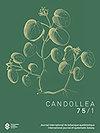On the proper type designation for Camelina microcarpa, a wild relative and possible progenitor of the crop species C. sativa (Brassicaceae)
IF 0.7
4区 生物学
Q4 PLANT SCIENCES
引用次数: 1
Abstract
Abstract Mosyakin, S.L. & J.R. Brock (2021). On the proper type designation for Camelina microcarpa, a wild relative and possible progenitor of the crop species C. sativa (Brassicaceae). In English, English abstract. Candollea 76: 55–63. The proper type designation of the name Camelina microcarpa Andrz. ex DC. (Brassicaceae) is discussed. This taxon is currently considered to be a wild relative and possible progenitor of the oilseed crop Camelina sativa (L.) Crantz, and thus the proper typification of the name C. microcarpa is important for further germplasm research and improvement of the crop species. At present, several (at least four) specimens deposited in herbaria G-DC, KW, and LE, are listed in literature and/or annotated in herbaria or online databases as the type (holotype or lectotype) of C. microcarpa. The original material deposited in G-DC [G00203789] is accepted here as the holotype of C. microcarpa because it appears to be the only original element used by Candolle when preparing his description of the new taxon. Isotypes from the Besser herbarium at the National Herbarium of Ukraine in Kyiv (KW-BESS) are discussed and illustrated. It is concluded that the holotype from G-DC and two well-preserved isotypes from KW-BESS [KW001003103, KW001003104] are sufficient for precise morphology-based application of the name C. microcarpa. Our analysis provided evidence that original material was collected by Andrzejowski no later than 1818 in the Podolian Governorate of the former Russian Empire, most probably in the eastern part of Moldova or adjacent southwestern parts of Ukraine, along the Dnister (Nistru, Dniester) River between the present-day town of Camenca (Kamenka) and the confluence of the Dnister and Yagorlyk (Iagorlîc) rivers, probably on limestone outcrops. It means that the type of C. microcarpa may belong to the southern Ukrainian populations, which are genetically different from northern and central Ukrainian ones; however, further field and molecular studies are needed because more than one genotype may in fact occur in that area. Received: August 7, 2020; Accepted: November 26, 2020; First published online: February 1, 2021油菜科野生近缘植物、可能的祖先——小油茶属植物的适当类型命名
Mosyakin, S.L. & J.R. Brock(2021)。油菜科野生近缘植物和可能的祖先——小油茶属植物的适当类型命名。英文,英文摘要。烛台76:55-63。小叶茶树名称的正确类型名称。前女友。(芸苔科)。该分类群目前被认为是油料作物Camelina sativa (L.)的野生近缘种和可能的祖先。因此,正确的分型对进一步的种质资源研究和作物品种改良具有重要意义。目前,在G-DC、KW和LE的几个(至少四个)标本被文献和/或在植物标本馆或在线数据库中注释为微carpa的类型(全型或lectotype)。在G-DC [G00203789]中沉积的原始物质被认为是C. microcarpa的完整模式,因为它似乎是Candolle在准备描述新分类单元时使用的唯一原始元素。本文讨论了乌克兰基辅国家标本馆(KW-BESS)贝塞尔标本室的同型。因此,G-DC的全型和KW-BESS的两个保存完好的同型[KW001003103, KW001003104]足以作为C. microcarpa名称的精确形态学应用。我们的分析提供的证据表明,原始材料是由安德热约斯基不迟于1818年在前俄罗斯帝国的波多利亚省收集的,最有可能是在摩尔多瓦东部或邻近的乌克兰西南部,沿着现在的卡蒙卡镇(Kamenka)和德尼斯特河和Yagorlyk河(iagorl)汇合处的德尼斯特河(Nistru, Dniester),可能是在石灰岩露头上。这意味着微卡帕的类型可能属于乌克兰南部的种群,与乌克兰北部和中部的种群在遗传上不同;然而,需要进一步的实地和分子研究,因为在该地区实际上可能发生不止一种基因型。收稿日期:2020年8月7日;录用日期:2020年11月26日;首次在线发布:2021年2月1日
本文章由计算机程序翻译,如有差异,请以英文原文为准。
求助全文
约1分钟内获得全文
求助全文
来源期刊

Candollea
生物-植物科学
CiteScore
1.20
自引率
33.30%
发文量
16
审稿时长
>12 weeks
期刊介绍:
Candollea is an international peer-reviewed journal that publishes original scientific papers, preferably in English but also in French. Spanish language manuscripts will be evaluated only if linked to scientific projects involving the Conservatoire et Jardin botaniques de Genève. Successful submissions will be in the fields of evolution, molecular systematics, morphology-anatomy, nomenclature, taxonomy, or vegetation analyses of plants. Reviews and articles on the history of botanical collections are welcome. New distribution records lacking pertinent analyses will not be considered. Manuscripts dealing with nomenclature alone will be considered only if clearly related to the Geneva library or herbarium (G). Authors are encouraged to deposit duplicates of their material, especially nomenclatural types, at G.
 求助内容:
求助内容: 应助结果提醒方式:
应助结果提醒方式:


